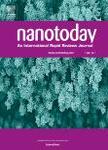版权所有:内蒙古大学图书馆 技术提供:维普资讯• 智图
内蒙古自治区呼和浩特市赛罕区大学西街235号 邮编: 010021

作者机构:Chinese Acad Sci Shenzhen Inst Adv Technol Lab Inflammat & Vaccines Shenzhen 518055 Guangdong Peoples R China Chinese Acad Sci Lab Immunol & Nanomed Shenzhen 518055 Guangdong Peoples R China Chinese Acad Sci Shenzhen Inst Adv Technol China Italy Joint Lab Pharmacobiotechnol Med Immun Shenzhen 518055 Guangdong Peoples R China Chinese Acad Sci Shenzhen Inst Adv Technol Res Ctr Human Tissues & Organs Degenerat Shenzhen 518055 Guangdong Peoples R China Chinese Acad Sci Ctr Biosafety Mega Sci Kunming Inst ZoolKey Lab Anim Models & Human Dis Key Lab Bioact Peptides Yunnan ProvKIZ CUHK Joint Kunming 650223 Peoples R China Paris Lodron Univ Salzburg Dept Biosci & Med Biol A-5020 Salzburg Austria Loyola Univ Chicago Stritch Sch Med Dept Med Div HepatolProgram Expt & Theoret Modeling Maywood IL 60153 USA Southern Univ Sci & Technol Shenzhen 518055 Guangdong Peoples R China CSIC Instiut Catala Nanociencia Nanotecnol ICN2 Campus UAB Barcelona 08193 Spain Barcelona Inst Sci & Technol BIST Campus UAB Barcelona 08193 Spain CIBER Bioingn Biomat & Nanomed CIBER BBN Bellaterra Spain Vall dHebron Inst Recerca VHIR Barcelona 08035 Spain Chinese Acad Sci Inst High Energy Phys CAS Key Lab Biomed Effects Nanomat & Nanosafety Beijing 100049 Peoples R China Vall dHebron Inst Recerca VHIR Barcelona 08035 Spain Inst Catalana Recerca i Estudis Avancats ICREA Barcelona 08010 Spain
出 版 物:《NANO TODAY》 (Nano Today)
年 卷 期:2024年第55卷
核心收录:
学科分类:07[理学] 070203[理学-原子与分子物理] 0805[工学-材料科学与工程(可授工学、理学学位)] 0703[理学-化学] 0702[理学-物理学]
基 金:National Key R & D Program of China [2021YFE0113000, 2022YFC2303700] National Natural Science Foundation of China [82261138630, 32171390, 32201154, 51872318, 32371469, 31971322] Natural Science Foundation of Guangdong Province [2023A0505050123, 2023B1515020104, 2022A1515010549] International Partnership Program (IPP) of CAS [172644KYSB20210011] Key Collaborative Research Program of the Alliance of International Science Organizations [ANSO-CR-KP-2022-01] CAS President's International Fellowship Initiative [2020VBA0022] Austrian Academic Exchange Service (OeAD) [CN06/2021] SmartCERIALS project of the Austrian Research promotion Agency (FFG)
主 题:Protein corona Protein 3D Structure Selective binding protein SARS-CoV-2 Cerium oxide nanoparticles
摘 要:The selective interaction of nanomaterials with proteins for protein function suppression has been reported. However, whether the nanomaterials could be used to target a three-dimensional (3D) structure of proteins for the consequent function inhibition is not defined. When SARS-CoV-2 binds to the host cell surface ACE2 receptor, the spike protein trimer changes to an Open State which forms a 5 nm cavity structure, consequently exposing the receptor binding domain (RBD) for the following viral infection. We found that the 3 nm cerium oxide nanoparticles (CeO2@3) showed a better anti-SARS-CoV-2 effect than 30 nm cerium oxide nanoparticles (CeO2@30). We performed a series of experiments and demonstrated that the CeO2@3 could target the 5 nm spike protein trimer cavity and tightly bind with the RBD, thus effectively blocking the following virus-cell interaction and rendering CeO2@3 as an effective anti-viral agent. As all coronaviruses possess similar spike protein structures as homologous proteins, CeO2@3 can be used as a broad-sperm anti-coronavirus nanodrug candidate by targeting the spike protein 3D structure. This work, for the first time, demonstrated that rationally engineered inorganic nanomaterials can be used to specifically target a 3D structure of a certain protein for function inhibition, thus providing a novel methodological approach and paving the way for future molecular targeting nanodrug candidate design.